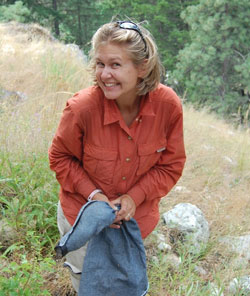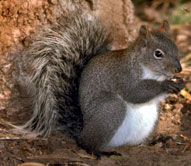 |
|||||
| Forest Resources Home | News | Make a Gift | UW Alumni | |||||
|
September 2010 | Return to issue home
Western Gray Squirrels: Can State's Populations Survive?
Wildlife science researchers at SFR have studied Washington’s western gray squirrels since the late 1990s in an effort to discover ways to help the species survive. The squirrel has been a state-threatened species since 1993. Once common in dry forests where oak, pine and Douglas-fir mix, western gray squirrels are now limited to three areas in Washington: the southern Puget Trough, primarily at Joint Base Lewis-McChord; the Methow Valley in Okanogan County and the north shore of Lake Chelan in Chelan County; and in the river valleys of Klickitat and southern Yakima counties. Western gray squirrels can live at elevations of up to 8,000 feet; they nest inside the hollow parts of trees or make nests on trees out of moss, twigs and other plant materials. They are also found in Oregon, California and in a small part of Nevada. Threats to their persistence include habitat loss and degradation, competition from the non-native eastern gray squirrel, fluctuating food supplies, disease and mortality from road-kill and illegal shooting. The largest native tree squirrels in Washington, western grays are salt-and-pepper to steel gray on the back with contrasting white underparts, and are distinguished by their long and bushy white-edged tails, large feet and prominent ears. Their tails are used for balance when dashing between tree branches. They make loud barking sounds, flick their tails and stamp their feet when threatened by potential predators or unwanted guests in their territory. Their "barking" can be very loud and many animals and people will actually hear a western gray squirrel long before they see it. They forage for food a large part of their day, and whatever food isn’t eaten is either hidden or taken back to the nest. A daily squirrel diet includes nuts, acorns, pinecone seeds, bark and berries. They have a wonderful memory of where they previously buried food, and a strong sense of smell; both help them find food they have tucked away. In Washington, the western gray squirrel’s status as a threatened species has resulted in restrictions on some management activities such as tree harvest. Forest managers also need strategies to manage western gray squirrel habitat that is increasingly being occupied by the non-native eastern gray squirrels. West and his graduate students have studied the species throughout its range in Washington, trying to discover more about its habitat requirements, its competitors and, ultimately, its chances for survival. Mary Linders, ’00, was West’s first graduate student to study the western gray squirrel. Her work was done in Klickitat County on the largest population of squirrels in the state. The project was funded by the Washington Department of Fish & Wildlife (WDFW) and resulted in her master's thesis, "Spatial Ecology of the Western Gray Squirrel, (Sciurus griseus) in Washington: The Dynamic Interaction of Season, Habitat, and Home Range," part of which appeared as a 2004 paper in the Journal of Mammalogy: "Seasonal Variability in the Use of Space by Western Gray Squirrels in Southcentral Washington.” In 2007, Ph.D. student Aaron Johnston began to study competition between eastern and western gray squirrels on the Joint Base Lewis-McChord Military Reservation in conjunction with a WDFW project. Says Johnston, "Only a small population of western grays is hanging on there, and little is known about competitive interactions between the two species." His research is comparing data obtained from western gray squirrels that have been radio collared by WDFW to his study population of eastern gray squirrels also equipped with radio transmitters. Data suggest that the two species occupy exclusive territories differing in some habitat structure and proximity to wetlands, but, says Johnston, "competition can’t be identified as the cause of interspecies avoidance without manipulating the abundance of competitors. Thus, we are experimentally removing eastern gray squirrels from selected sites to evaluate competitive effects based on resulting behavior, use of resources, spatial partitioning and differences in reproduction and survival." To complicate matters, another native squirrel on the military base, the Douglas squirrel, potentially presents additional competition among the species. For example, Johnston’s research suggests that Douglas squirrels’ abundance increased on a site where eastern gray squirrels were removed. The patterns of habitat selection and interspecies avoidance found at Lewis-McChord may not extend throughout the range of the western gray squirrel because of habitat variation among region. "It’s important," says Johnston, "to evaluate the degree of competition between these species elsewhere in the Pacific Northwest." The project is now expanding to Klickitat County, and to selected sites in Oregon’s Willamette Valley.
Of the three populations in Washington state, the least is known about the North Cascades population; this population’s remote location at the far northern edge of the western gray squirrel’s range and the technical challenges of studying a low density mammal population make research difficult. Here, deep snow blankets the ground for much of the winter, and there are no oaks to provide acorns for food and cavities for maternal nests. Ponderosa pine and Douglas-fir are the dominant tree species, and the squirrels eat seeds or nuts from pines and firs, mushrooms, and perhaps other foods, and must construct their nests from branches, needles and other vegetation. A history of fire suppression in this area has led to dense and often diseased forest stands that are prone to catastrophic wildfires. Research conducted in 2003-04 by Sara Gregory, ’05, and WDFW scientists investigated the North Cascades western gray squirrels’ distribution and habitat needs. Study objectives included describing the characteristics of gray squirrel nests in an area lacking oak trees and quantifying nest selection relative to the availability of nesting sites at two spatial scales (the nest tree and the site containing the nest tree). The study found that the squirrels showed a preference for building nests in relatively tall ponderosa pines standing in clumps rather than as isolates and in which mistletoe broom was present; the broom was used by the squirrels as part of the nest structure. The structure created by the mistletoe deformations appeared to enhance nesting opportunities for the squirrels, perhaps filling a gap created by the lack of oak cavities for dens. Research on the North Cascades population is being conducted by graduate student Katy Stuart, who is beginning her fourth year of gathering data. Stuart started by live-capturing and radio-collaring squirrels near Stehekin, Wash., the northernmost documented extent of the squirrel’s range, where she monitored their movements, located nest sites and is currently studying how fire and management practices of thinning and prescribed burns impact the species’ habitat. In this study all but four of her radio-collared squirrels died, mostly from predation, but also from starvation and disease. "Stehekin represents an edge habitat for the western gray squirrel and predation takes its toll," says Stuart—the squirrels generally only live about two years, and they don’t reach mating maturity until they reach one year. With so many other threats to the population here, it is even more important for managers to design forest practices that conserve or enhance habitat, rather than destroy it." She is now monitoring squirrels in the lower Methow Valley, where similar fire fuel reduction treatments are being carried out on public lands. Adds Stuart, "Other interesting things I have found include long distance movement—one male relocated 14 miles from where he was collared, and others have traveled up to eight miles in just one day. (Long-distance movements like this generally indicate lower quality habitat.) Aaron and I are also taking genetic tissue samples and fecal samples to understand diet, conservation status and social dynamics; for example, are squirrels more likely to share a nest or have overlapping home ranges if they are more related to each other?" "Understanding exactly what squirrels need and what types of treated areas are most appealing to them," says West, "will help both reduce wildfire risk and conserve squirrel habitat for this threatened species." September 2010 | Return to issue home | |||||
|
|||||

